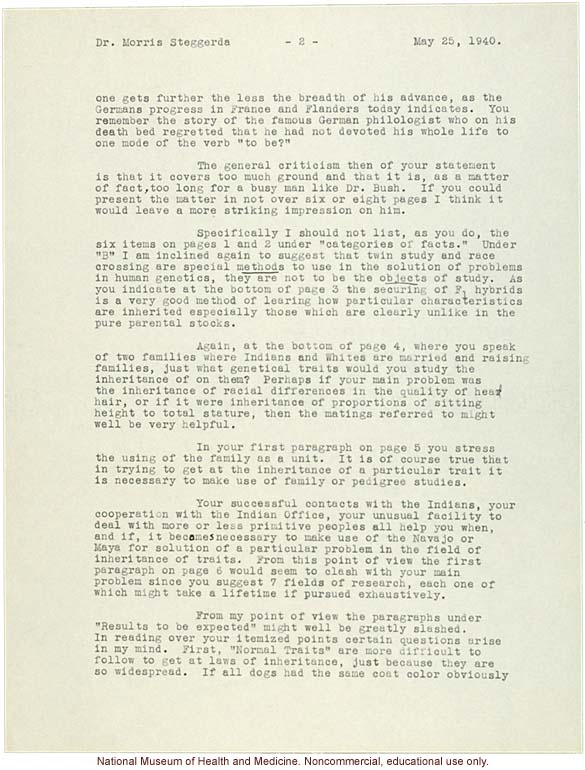Dr. Morris Steggerda -2- May 25, 1940.
one gets further the less the breadth of his advance, as the Germans progress in France and Flanders today indicates. You remember the story of the famous German philologist who on his death bed regretted that he had not devoted his whole life to one mode of the verb "to be"?
The general criticism then of your statement is that it covers too much ground and that it is, as a matter of fact, too long for a busy man like Dr. Bush. If you could present the matter in not over six or eight pages I think it would leave a more striking impression on him.
Specifically I should not list, as you do, the six items on pages 1 and 2 under "categories of facts." Under "B" I am inclined again to suggest that twin study and race crossing are special [underscore]methods[end underscore] to use in the solution of problems in human genetics, they are not to be the [underscore]objects[end underscore] of study. As you indicate at the bottom of page 3 the securing of F[inferior]1[end inferior] hybrids is a very good method of learning how particular characteristics are inherited especially those which are clearly unlike in the pure parental stocks.
Again, at the bottom of page 4, where you speak of two families where Indians and Whites are married and raising families, just what genetical traits would you study the inheritance of on them? Perhaps if your main problem was the inheritance of racial differences in the quality of head hair, or if it were inheritance of proportions of sitting height to total stature, then the matings referred to might well be very helpful.
In your first paragraph on page 5 you stress the using of the family as a unit. It is of course true that in trying to get at the inheritance of a particular trait it is necessary to make use of family or pedigree studies.
Your successful contacts with the Indians, your cooperation with the Indian Office, your unusual facility to deal with more or less primitive peoples all help you when, and if, it becomes necessary to make use of the Navajo or Maya for solution of a particular problem in the field of inheritance of traits. From this point of view the first paragraph on page 6 would seem to clash with your main problem since you suggest 7 fields of research, each one of which might take a lifetime if pursued exhaustively.
From my point of view the paragraphs under "Results to be expected" might well be greatly slashed. In reading over your itemized points certain questions arise in my mind. First, "Normal Traits" are more difficult to follow to get at laws of inheritance, just because they are so widespread. If all dogs had the same coat color obviously
[end]


